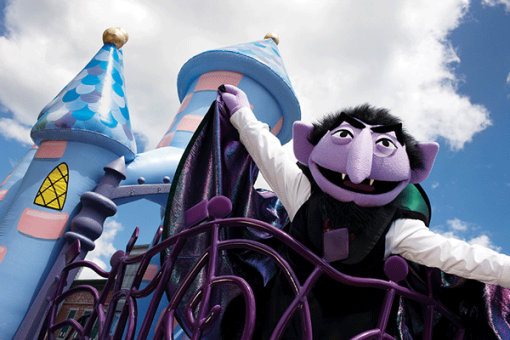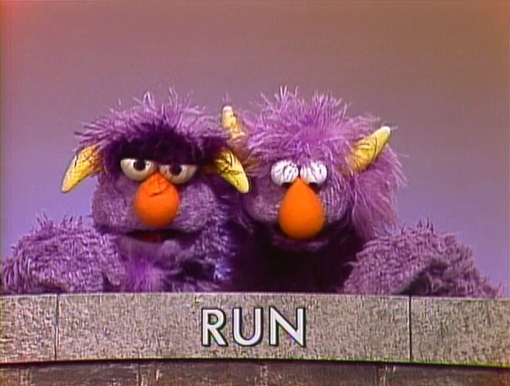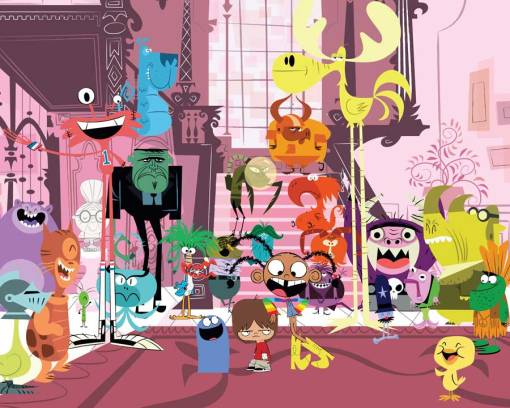
We’ll see plenty of kids roaming the streets tonight clad in horns, fangs and claws. But all the embrace of monsters by kids leaves me scratching me head. After all, monsters are supposed to be scary, right? The scaly, twelve-eyed, sharp-fanged creatures that lurk underneath your bed and in the shadows of your closet? I remember going to bed paranoid as a kid, begging my mom to use her can of “monster spray” like Raid around my room (in reality it was an empty can of hairspray). Everywhere I look I see monsters of all scary shapes and sizes, and kids aren’t running scared but, for some strange reason, smiling.
From “Monsters Inc.” to “Moshi Monsters” to “Yo Gabba Gabba,” friendly monsters seem to be all the rage. To be sure, these furry friends are not the creepy creatures of our nightmares, but they’re monsters nonetheless: strange, grotesque beings that lurk in surreal worlds. University studies and popular media tell us that kids of all stripes are creeped out by clowns, which are just people in makeup, but why do monsters, who seem much more menacing and not remotely human, get a pass?
To solve this monstrous riddle, let’s take a look at the history of friendly monsters in pop culture. One of the first monsters to come to life on the big screen was Nosferatu, the grotesque German vampire from the 1922 silent film by the same name. From the ’20s through the ’60s Universal studios expanded the movie monster pantheon with Dracula, Frankenstein, The Mummy, The Wolf Man, and The Creature From the Black Lagoon. As movie magic improved, monsters got a lot more imaginative and a whole lot scarier. (I try not to revisit my own run-in with a particular slash-em-up movie back in the ’80s that had me in my parents’ bed all night.)

Somewhere along the line, we gained an appreciation for monsters. Call it facing our fears head-on or humanizing our horrors; whatever the reason, our culture started seeing a friendlier brand of monster.
While you can look as far back as Frankenstein or King Kong for evidence of violent but deeply misunderstood monsters, one of the biggest caches of friendly monsters came to us in 1969 in a place called Sesame Street.
Jim Henson’s famous Muppets came in all stripes. There were real-life animals like Big Bird and Kermit the Frog, and there were human-like characters like Bert and Ernie. Most of the other Muppets that filled out the cast, however, were legitimate monsters. There was, of course, Cookie Monster, whose only victims were chocolate chip cookies; Oscar the Grouch, who was generally a jerk but earned our sympathy over time; even the grotesquely adorable two-headed monster, who despite its abnormality taught kids about cooperation. We also had Count van Count – an actual vampire, albeit one who prefers arithmetic to blood – but with his foam head and cheery disposition, he was a far cry from the villainous Nosferatu.
On Sesame Street, monsters weren’t scary creatures of the dark, they were cuddly stuffed animals who had fears and insecurities just like us. Since the ’60s various cuddly monsters have cropped up from time to time. 1969 gave us the psychedelic monsters of H.R. Pufnstuf, in 1984 we were introduced to Gizmo, the adorable counterbalance to the creepy cast of Gremlins, and in 1997 we were introduced to the neurotic leads of Nickelodeon’s Aaahh!!! Real Monsters. By 2001 we had both Shrek, featuring the lovable Ogre, and Monster’s Inc. which gave those scary monsters under the bed silly, relatable personalities.

That last bit really hits the nail on the head. While Universal’s monsters were emotionless cretins, this new batch of friendly monsters have human emotions, including fears and insecurities of their own. Those emotions let kids relate, and erase any fear of the grotesque creatures. Once the fear is gone, monsters are just like people, only they look a little funny.
Once the fear is out of “monsters” the creatures are a blank canvas for imaginative expression. Look no further than Yo Gabba Gabba or the brilliantly surreal Foster’s Home for Imaginary Friends for wild, beautiful interpretations of monstrous beings. Because the only thing monsters look like is not us, they have free reign to look like anything. That free spirit of creativity is appealing to kids, who live in the limitless world of imagination already.
Having claws and fangs doesn’t have to be menacing anymore. Your child can be a monster who just likes cookies, or better yet – vegetables! Your little monster doesn’t have to be monstrous at all, because being a monster today just means looking a little different. Frankenstein’s monster would be proud.
